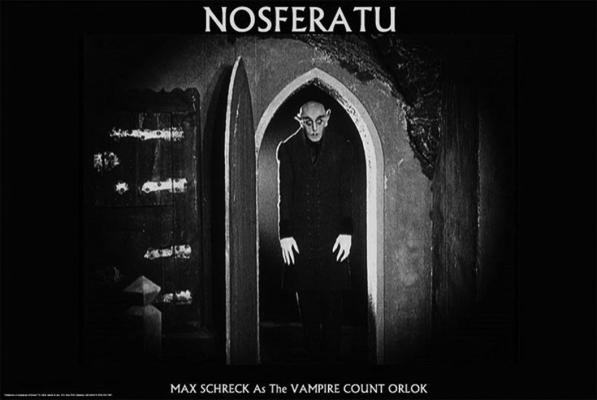100 years later, Nosferatu still haunts the imagination
And now we come to our final film for this Halloween season, and one of the oldest movies we’ve covered: Nosferatu.
Although somewhat known via pop culture osmosis, I feel as though few people have watched Nosferatu. Which is a shame considering influence it would have on the genre of vampire horror films.
The film is an unofficial adaptation of Bram Stoker’s Dracula, lifting many of the plot elements while also changing character names (Count Dracula becomes Count Orlok, Johnathan Harker becomes Thomas Hutter and so on) and dropping several secondary characters to streamline the plot. Additionally, the location is changed from London to a fictitious German town, and the methods that Orlok employs are different from the novel Dracula, as he does not turn others into vampires and is also vulnerable to sunlight (the original Dracula was able to walk about in the day, but his powers would be weakened); in fact, Orlok is the first vampire to be killed by sunlight in a movie.
The film, while not considered “scary” by any means, has a haunting and dreamlike quality to it. This is owed in large part to the style in which in was produced known as German Expressionism. This style lends itself to bizarre, outlandish and highly stylized sets, dramatic lighting and camera angles. Count Orlok himself (played excellently by Max Schreck) is almost like a physical manifestation of the sleep paralysis demons/shadow people some people experience. He moves like you’d imagine a “living” corpse to, his performance is magnified by the use of the sets and camera. The famous scenes of Orlok’s shadow climbing up the stairs, walking into a doorway that perfectly contorts to the shape of his body, and rising vertically up from his coffin, all serve to help enhance the eerie “wrongness” of the vampire.
This movie was produced by Prana Film in what would’ve been their intent to produce several supernatural and occult related films, but alas, this would be their only film as the company declared bankruptcy following this movie’s release.
And although we talk about this movie now, it was very nearly lost to us.
Despite the changes to character names and plot elements, there were still enough that the heirs of Bram Stoker sued over the adaptation, and a court ruling ordered that all copies of the movie be destroyed.
Fortunately for film history, several prints survived the purge.
For the longest time, this movie was considered to be in the public domain, but didn’t actually enter into it world wide until the end of 2019. The film had various different versions released since 1981 that all were all speed corrected, tinted and had specially recorded scores that were copyrighted. This means that your experience might vary when watching the movie as some versions even have different run times depending on the transfer speed. For clarity, I was watching from a 1991 release for this retrospective.
The film was remade in 1979 as Nosferatu the Vampyre, and a movie about the (fictional) making of the movie called Shadow of the Vampire was released in 2000.
That concludes our Halloween celebrations, I love sharing the history and details of older horror and monster films as watching them is one of my favorite pastimes in October.
So set out the trick or treat bowl, turn out the lights, and check out some great horror films to celebrate your Halloween in style.
Happy Halloween folks!


